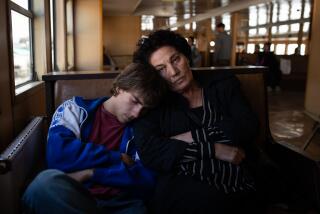Review: ‘The Other Side of Hope’ is an offbeat Finnish refugee tale with a lot of heart
- Share via
Aki Kaurismaki, the Finnish director with the euphonious name, is a filmmaker who goes his own way, and never more so than in “The Other Side of Hope.”
Known for idiosyncratic work that is improbable and endearing, products of the most deadpan comic sen
sibility since Buster Keaton, Kaurismaki’s wacky films come with sui generis titles like “Leningrad Cowboys Go America” and “Take Care of Your Scarf, Tatiana.”
Yet starting with Kaurismaki’s last feature, 2011’s marvelous “Le Havre,” an unlikely political subtext has joined the madness. “The Other Side of Hope” and its unapologetic plea for understanding for refugees flooding Europe adds to that trend.
“In Finland, 30,000 Iraqi refugees arrived, and both the young Finnish and old Finnish took it as a war — ‘somebody’s attacking us,’ like Russia 50 or 60 years ago,” Kaurismaki said at the Berlin Film Festival, where his film won the Silver Bear for best director.
“This attitude was intolerable, in my opinion, and I didn’t like to see that in my compatriots.”
The story here, written by Kaurismaki, is simplicity itself, the tale of two men, strangers to each other, who want to begin life anew on the quirky streets of Helsinki.
One man, a traveling salesman named Wikstrom, is a familiar figure in the Kaurismaki universe, a tired, middle-aged man whose life is going nowhere.
Wikstrom, played by Kaurismaki veteran Sakari Kuosmanen, is introduced turning his life around, starting by packing a battered suitcase and leaving his seemingly indifferent, alcoholic wife behind.
After emptying his storage unit of the 6,000 shirts that are his stock in trade, Wikstrom goes to a clandestine poker game in the hopes of earning enough money to fulfill his dream of owning a restaurant.
The place he ends up with, an indifferent seafood joint called the Golden Pint, is no one’s idea of a dream comes true, but Wikstrom has big plans for it, some crazier than others but all quite amusing to observe.
Alternating with Wikstrom’s saga is the story of Khaled (Sherwan Haji), a refugee from Aleppo, Syria, who in a typical Kaurismaki touch, sneaks into Helsinki by stowing away in a ship’s enormous coal bin. Khaled’s horrific story of death and exile is delivered directly to the camera, no frills allowed.
It’s only natural in AkiWorld that Khaled and Wikstrom come together around that restaurant, but that doesn’t mean things are easy.
Taunting Khaled whenever they come across him are hooligans from the Liberation Army of Finland, who try their best to make his life miserable.
But while the conclusion to “The Other Side of Hope” is open-ended, Kaurismaki unashamedly believes in brotherhood, and among other things his film celebrates people who do the right thing without making a big deal about it.
And though the director has become political, he has hardly abandoned his offbeat, slyly ridiculous style, creating a world where looking happy is so forbidden that Khaled is told that if he smiles on the street people will think he is crazy.
A big fan of rockabilly-tinged Finnish popular music, Kaurismaki as always finds room for musical interludes played by a variety of aging hipsters.
As photographed by Kaurismaki’s regular cinematographer Timo Salminen, the poet of deserted streets, “Hope” indulges in the director’s usual fondness for unlikely pastels and bright red items like ever-present fire extinguishers.
Then there is that huge portrait of Jimi Hendrix dominating a wall in the Golden Pint. As with most things Kaurismaki, you don’t ask what on earth it’s doing there, you just go with the flow.
------------
“The Other Side of Hope”
Not rated
Running time: 1 hour, 38 minutes
Playing: Landmark’s Nuart, West Los Angeles
------------
See the most-read stories in Entertainment this hour »
Movie Trailers
More to Read
Only good movies
Get the Indie Focus newsletter, Mark Olsen's weekly guide to the world of cinema.
You may occasionally receive promotional content from the Los Angeles Times.











